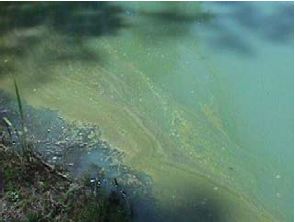



Control of Nuisance Algal Blooms in Ponds Used to Water Livestock
Algal blooms are best controlled by 'careful' use of herbicides and limiting the amount of nutrients entering the water,cattlemen in Georgia are being told.In some cases, blue-green algae can produce toxins that cause animal sickness or death, writes Dr Gary Burtle, Extension Aquaculture Specialist. More commonly, thick scums (Figure 1) on the top of a pond may be unsightly or foul smelling. Thankfully, toxic algal blooms are rare. Here are some preventative measures.
Several herbicides have been utilized to control the densities of algal populations. The most commonly used algicide is copper. Copper is available in several forms that include copper sulfate powder, liquid copper complexes such as copper EDTA, and liquid organic copper salts such as copper citrate.
The different solubility of each form of copper allows them to be utilized effectively under different conditions. The liquid formulations of copper usually stay dissolved longer, so that lower concentrations are effective controls for algae. Other herbicides for algae control include diquat, endothal, and sodium percarbonate.
Recently, research at Mississippi State and USDA compared herbicides for control of certain algae. The blue-green algal species of concern was one that releases a chemical that causes the off-flavor condition in catfish. Diquat (Reward) and copper (Copper Control – product of Argent Chemical Laboratories, Redmond, WA) were effective at relatively low concentrations for control of the blue-green algae.
However, copper was not selective and also killed desirable species of green algae. Diquat was less toxic to the green algal species tested than it was to the blue green algae. Endothal (as Hydrothol-191) kills blue-green algae, however it must be used more carefully than diquat because it can be toxic to fish at rates near those that kill algae. Use the rate of application defined on each chemical label.

At Tifton, copper sulfate powder and sodium percarbonate were used in combination to control blue-green algae. The combination was used in order to lower the amount of copper sulfate necessary to control algae to as low as 0.1 ppm or 0.27 pounds of copper sulfate per acre-foot of water.
That was accomplished when 8 to 25 pounds of sodium percarbonate (as PAK-27) was applied after the copper sulfate treatment. Blue-green algae control was achieved and lasted up to one month after treatment. Non-harmful green algae continued to grow with little effect from this herbicide combination.
Herbicides are most effective when used together with other types of weed management. For algae control, nutrient control is important to reduce future growth of algae after the herbicide leaves the water column or decomposes. The algae use abundant nutrients and light in the shallow ponds used for aquacultural production.
Some fish species may be utilized to recover the wasted nutrients from catfish feeding by harvesting the algae and zooplankton that utilize the nitrogen and phosphorus the catfish do not use. Blue gill sunfish utilize algae and zooplankton as food. Fish with a planktivorous diet, like threadfin shad, can reduce algal populations andincrease the diversity of species within those populations. However, stocking additional fish species is not always possible. However, both the bluegill sunfish and the threadfin shad are good forage fish for largemouth bass.
Correction of environmental conditions that may lead to nuisance algal blooms is also needed for sustained control. Maintaining normal water levels in ponds will help. Limit the access of animals to your pond in order to reduce nutrient additions. Fence the pond to allow only one point of access. Allow a strip of grass to grow between the pond and sources of nutrients. In some cases a water line should be run from the pond to a water tank so that animal access to the pond is restricted. Over time, ponds recover from nutrient pollution, if the source of pollution is checked.
Careful utilization of aquatic herbicides is the best way to control algae in fish ponds. Use the lowest effective rate of application and apply for specific problems that are accurately identified. Most of the county agents in Georgia are trained in aquatic plant identification and are familiar with aquatic herbicides. Your local county agent is the best place to start to find answers to your algae control problems.
If you think toxic algae are present, ask your county extension office to process a sample of the dense algal bloom for toxin presence.increase the diversity of species within those populations. However, stocking additional fish species is not always possible. However, both the bluegill sunfish and the threadfin shad are good forage fish for largemouth bass.
Correction of environmental conditions that may lead to nuisance algal blooms is also needed for sustained control. Maintaining normal water levels in ponds will help. Limit the access of animals to your pond in order to reduce nutrient additions.
Fence the pond to allow only one point of access. Allow a strip of grass to grow between the pond and sources of nutrients. In some cases a water line should be run from the pond to a water tank so that animal access to the pond is restricted. Over time, ponds recover from nutrient pollution, if the source of pollution is checked.
Careful utilization of aquatic herbicides is the best way to control algae in fish ponds. Use the lowest effective rate of application and apply for specific problems that are accurately identified. Most of the county agents in Georgia are trained in aquatic plant identification and are familiar with aquatic herbicides. Your local county agent is the best place to start to find answers to your algae control problems. If you think toxic algae are present, ask your county extension office to process a sample of the dense algal bloom for toxin presence.


